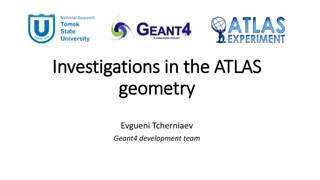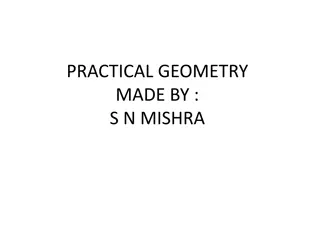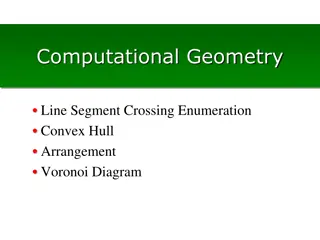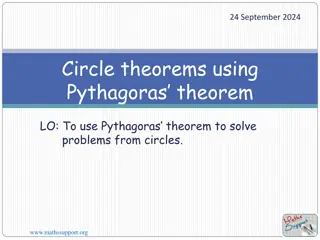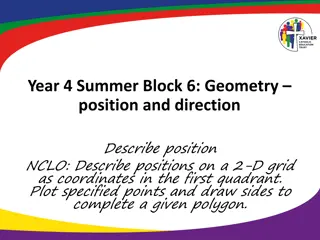Mastering Computational Geometry: Problem-Solving Strategies
Explore the world of computational geometry through practical problems like finding the closest pair of points in a 2D plane. Delve into the divide and conquer approach to efficiently solve complex geometric challenges. Uncover insights on organizing points, sorting by x-values, and handling proximity computations. Refine your skills to tackle advanced scenarios with ease. Elevate your problem-solving prowess in computational geometry today.
Download Presentation

Please find below an Image/Link to download the presentation.
The content on the website is provided AS IS for your information and personal use only. It may not be sold, licensed, or shared on other websites without obtaining consent from the author.If you encounter any issues during the download, it is possible that the publisher has removed the file from their server.
You are allowed to download the files provided on this website for personal or commercial use, subject to the condition that they are used lawfully. All files are the property of their respective owners.
The content on the website is provided AS IS for your information and personal use only. It may not be sold, licensed, or shared on other websites without obtaining consent from the author.
E N D
Presentation Transcript
What did we talk about last time? Counting inversions
Imagine you are in a completely dark room with a deck of cards containing 10 cards that are face up and the rest face down How can you create two piles of cards (not necessarily the same height) that both contain the same number of face up cards? If you fail, you'll be eaten by a grue
Imagine you have a set of points in a 2D plane How do you find the pair of points that's closest? This is a fundamental problem in the area of computational geometry As usual, you could look at all pairs of points
double smallest = Double.POSITIVE_INFINITY; Point p1, p2; for (int i = 0; i < n - 1; ++i) for (int j = i + 1; j < n; ++j) { double distance = points[i].distance(points[j]); if (distance < smallest) { smallest = distance; p1 = points[i]; p2 = points[j]; } } What's the problem with this algorithm? O(n2)
To make things simpler, we assume that no two points have the same x-coordinate or y-coordinate Think about a one-dimensional approach: Sort the list by x-value The two closest points must be next to each other in the list
Since the name of the chapter is divide and conquer, that's what we do First, sort all of the points by increasing x-values, calling this list Px Then, sort all of the points by increasing y-values, calling this list Py Find the median point in Px and drop a line through it, dividing the points into those with smaller x (set Q) and larger x (set R) Recursively find the closest pair of points on the left side and the closest pair of points on the right side
Q L R
We have magically recursively found the closest pair of points in Q and the closest pair in R Between those two pairs, let's say the closest has distance But what if the closest pair straddles L, with one point in Q and the other in R? We do a linear scan of Py, the list of points sorted by y values, making a new y-sorted list of points Sy whose x-coordinate is within of L
We scan through the list Sy For each element, we compute the distance between it and the next 15 elements We find the closest distance If the closest distance is smaller than , that's the true closest pair Otherwise, we use the smaller of the pairs from Q and R
First step: If there exists qQ and rR for which d(q, r) < , then each of q and r lies within a distance of L. Proof: Let x* be the x-coordinate of L. Let q = (qx, qy) and r = (rx, ry) By the definition of L , we know that qx x* rx Thus, x* qx rx qx d(q,r) < And, rx x* rx qx d(q,r) < Since q and r both have an x-coordinate within of x*, they are both within of L.
Let S be the set of points whose x-coordinate is within of line L. There exist q Q and r R for which d(q, r) < if and only if there exist s, s' S for which d(s, s') < . This is really just restating the last proof: The only way that q and r are the closest pair is if the closest pair wasn't completely in Q or R. The pair straddles L and must be within of it or can't possibly be the closest pair.
If s, s'S have the property that d(s, s') < , then s and s' are within 15 positions of each other in the sorted list Sy. Proof: Consider the subset Zof the plane consisting of all points within distance of L. We partition Zinto boxes: squares with horizontal and vertical sides of length /2. One row of Zwill consist of four boxes whose horizontal sides have the same y-coordinates.
Suppose two points of Slie in the same box. Since all points in this box lie on the same side of L, these two points either both belong to Qor both belong to R. But any two points in the same box are within distance ?/?< , which contradicts our definition of as the minimum distance between any pair of points in Qor in R. Thus each box contains at most one point of S.
Now suppose that s, s'Shave the property that d(s, s')< , and that they are at least 16 positions apart in Sy. Assume without loss of generality that shas the smaller y- coordinate. Then, since there can be at most one point per box, there are at least three rows of Zlying between sand s'. But any two points in Zseparated by at least three rows must be a distance of at least 3 /2 apart, which is a contradiction.
Pre-processing: Sort the points by x: O(n log n) Sort the points by y: O(n log n) Recursion: If there are three or fewer points, find the closest pair by comparing all pairs Otherwise, divide into sets Q and R: O(n) time Make lists Qx, Qy, Rx, and Ry, giving the points in Q and R sorted by x and y, respectively: O(n) time Construct Sy: O(n) time For every point in Sy (of which there can only be n), compute the distance to the next 15 points: O(n) ? ? 2? 2+ ?? which is ?(?log?) ?
Integer multiplication Master theorem
Start Homework 4 Read section 5.5 Extra credit opportunities (0.5% each): Hristov teaching demo: Hristov research talk: 2/19 11:30-12:25 a.m. in Point 113 2/19 4:30-5:30 p.m. in Point 139







